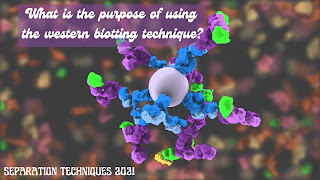What is the purpose of using the western blotting technique?
The blotting technique is a method for identifying
biomolecules including DNA, mRNA, and protein at various stages of gene
expression. Protein synthesis begins with the expression of a DNA segment,
which is then transformed to mRNA and then translated into the desired protein.
The target molecule that is sought determines the subtypes of blotting, such as
northern, western, and southern. When a DNA sequence is a foundation or code
for a protein molecule, the particular DNA molecule of interest can be blotted
using the Southern Blotting technique. Northern blotting can be used to
identify when DNA is expressed as mRNA for protein creation during gene
expression. Finally, the coded mRNA produces the desired protein, which can be
identified via Western Blotting.
Western blotting (also known as Immunoblotting) is a
popular method for detecting proteins and posttranslational modifications on
proteins in complicated materials. It uses antibody-based probes to extract
particular information about target proteins. In simple or complicated
biological samples, it can yield semi-quantitative or quantitative data on the
target protein.
The following is a general blotting technique, with
each step crucial for getting high-quality, reliable, and analyzable data.
1.
Make the sample as homogeneous as
possible.
2.
An electrophoresis membrane separates
the molecule of interest.
3.
The molecules are transferred to a nitro
cellulosic membrane or a nylon membrane.
4.
The molecule's hybridization or
identification
The technique of Western blotting is used to
separate or identify protein molecules. This method can be used to denature both
active 3D proteins and lengthy peptide chains. This method can be used to
investigate the characteristics and activity of a particular protein molecule.
Significant advancements in the basic western blot approach have been documented over the previous two decades. There have been reports of changes to the preparative phase (lysis buffers, homogenization), blotting (blotting reagents, apparatus, and techniques), and detection approaches. Western blots now take less time, are more reliable, and are more repeatable as a result of these changes.




Comments
Post a Comment